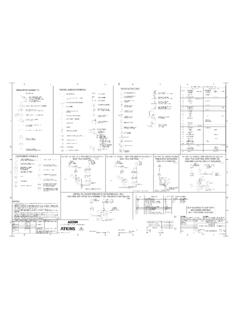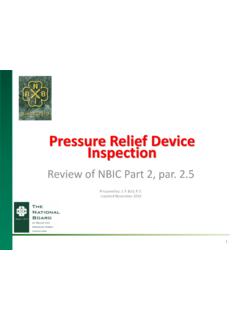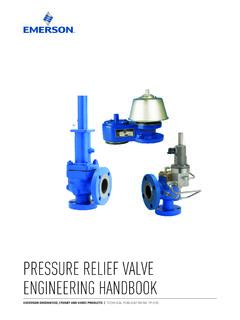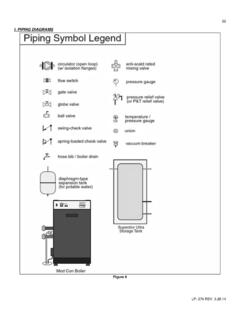Transcription of December 2015 630 Series Regulators and Relief Valves
1 630 SeriesD100300X012 December 2015 Instruction ManualForm Series Regulators and Relief ValvesIntroductionScope of ManualThis Instruction Manual provides operating, installation, maintenance and parts information for the 630 Series Regulators and Relief 630 Series consists of self-operated, spring loaded Type 630 Big Joe pressure Regulators and Type 630R Relief Valves , which are designed for maximum inlet pressures to 1500 psig / 103 bar and outlet pressures from 3 to 500 psig / to !WaRnIngPersonal injury, property damage, equipment damage or leakage due to escaping gas or bursting of pressure- containing parts may result if this regulator is overpressured or is installed where service conditions could exceed the limits given in Specifications section, Tables 1 through 3 or where conditions exceed any ratings of the adjacent piping or piping avoid such injury or damage, provide pressure-relieving or pressure-limiting devices (as required by the appropriate code, regulation or standard) to prevent service conditions from exceeding those , physical damage to the regulator could cause personal injury or property damage due to escaping gas.
2 To avoid such injury or damage, install the regulator in a safe installing, inspect the unit for any damage and any foreign material. The regulator or Relief valve may be mounted in any position, however, ensure that the flow direction corresponds with the direction of the arrow on the nameplate. Apply a good grade of pipe compound to the male threads of the 1. Spring-Loaded Type 630 RegulatorW1934630 Series2 SpecificationsThe Specifications section lists the specifications for the 630 Series ConfigurationsType 630: Spring-loaded reducing regulatorsType 630R: Spring-loaded Relief valvesBody Size1 and 2 in. / DN 25 and 50 End Connection StyleNPT, ASME CL150 RF, CL300 RF or CL600 RFMaximum allowable Inlet Pressures(1)Type 630 Regulators : See Table 1 Type 630R Relief Valves : See Table 3 Type 630 Outlet Pressure Ranges(1)3 to 500 psig / to bar with intermediate values shown in Table 2 Type 630R Relief Pressure Ranges(1)3 to 250 psig / to barSee Table 3 Maximum allowable Outlet Pressures(1)See Table 2 Maximum allowable Pressure Drops(1)See Table 1 Pressure Registration InternalSpring Case vent 1 /4 NPT Material Temperature Capabilities(1)Standard: -20 to 180 F / -29 to 82 COptional: -20 to 300 F / -29 to 149 COrifice Sizes1/8, 3/16, 1/4, 3/8 or 1/2 in.
3 , , , or mmCoefficients for Relief Valve SizingORIfICE SIzECgCV 3/161/43/81/2 Weights 1 In. End Connection: 25 lbs / kg 2 In. End Connection: 30 lbs / kg 1. The pressure/temperature limits in this Instruction Manual or any applicable standard limitation should not be !WaRnIngWhen the unit is installed in an enclosed area or indoors, escaping gas may accumulate and be an explosion hazard. Under these conditions the vent should be piped away from the unit to a freely ventilated outdoor location away from air intakes, windows, etc. Protect all vent openings against weather or the entrance of any foreign material that may plug the vent or affect operation of the regulator or Relief valve. Inspect all vent openings periodically to be sure they are not plugged. If the vent is in an environment where freezing rain, ice or snow could clog the vent, it is recommended that a weatherproof vent be constructions have a screened vent assembly (key 27, Figures 4, 5 and 6) installed in the 1/4 NPT spring case vent opening.
4 If a remote vent is required, remove the vent assembly and install a remote vent ProtectionAs is the case with most Regulators , the Type 630 spring-loaded Regulators have outlet pressure ratings that are lower than the inlet pressure ratings. Overpressure protection must be provided if the actual inlet pressure can exceed the outlet pressure rating. Overpressure protection is also required for the loading regulator and main regulator spring case of Relief to the following tables to determine pressure ratings:1. Spring-loaded Type 630 Inlet pressure and pressure drop Table Outlet pressure Table Spring-loaded Type 630R Relief valve pressure Table 3.!WaRnIngOverpressuring any portion of this equipment may cause damage to regulator parts, leaks in the regulator or personal injury due to bursting of pressure-containing parts or explosion of accumulated Series3 Table 2. Type 630 Regulator Outlet Pressure Ranges and Maximum Outlet PressuresREgUlaTORCOnSTRUCTIOnOUTlET PRESSURE RangESPRIng PaRT nUMBERMaXIMUM OPERaTIng OUTlET PRESSUREMaXIMUM OUTlET PRESSURE OVER SETPOInT(1)MaXIMUM EMERgEnCy OUTlET (CaSIng) PRESSURE(4)psigbarpsigbarpsigbarpsigbarl ow-Pressure3 to to to to to to (2) (2)27 to to by Maximum Emergency Outlet PressureHigh-Pressure27 to 5046 to 9590 to 150150 to 200200 to to to to to to to to (3) (2)1.
5 Damage to internal parts of the regulator may occur if outlet pressure exceeds the actual pressure setting by amounts greater than those shown in this For outlet pressure settings to 25 psig / bar only. For pressure settings over 25 psig / bar, outlet pressure is limited by maximum emergency outlet pressure of 45 psig / For outlet pressure settings to 350 psig / bar only. For pressure settings over 350 psig / bar, outlet pressure is limited by maximum emergency outlet pressure of 550 psig / Leakage or bursting of pressure-containing parts may occur if outlet pressure exceeds these 3. Type 630R Relief Pressure RangesRElIEf ValVECOnSTRUCTIOnRElIEf (InlET) PRESSURE RangEPaRT nUMBERMaXIMUM allOWaBlE Relief (InlET) PRESSURE, psig / barMaXIMUM EMERgEnCy InlET (CaSIng) PRESSURE(1)psigbarpsigbarlow-Pressure3 to 86 to 1715 to 2220 to 3535 to to to to to to Pressure Setting Plus Maximum Allowable Buildup of 25 psig / to 7050 to 9575 to 175150 to to to to to Pressure Setting Plus Maximum Allowable Buildup of 250 psig / Leakage or bursting of pressure-containing parts may occur if inlet pressure exceeds these avoid overpressure, provide an appropriate overpressure protection device to ensure that none of the limits listed in Specifications section, Tables 1 through 3 will be or Relief valve operation below the limits specified in Specifications section, Tables 1 through 3 does not preclude the possibility of damage from external sources or from debris in the gas line.
6 Inspect the regulator for damage after any overpressure up the unit consists of opening the upstream block valve, introducing gas pressure. Use gauges to monitor pressures during range of allowable pressure settings is marked on the nameplate. If a pressure setting beyond the nameplate range is required, substitute an appropriate spring selected from Table 5. Be sure to change the nameplate to indicate the new pressure 1. Maximum Allowable Inlet Pressures and Pressure DropsORIfICE SIzEMaXIMUM allOWaBlE InlET PRESSURE(1)MaXIMUM allOWaBlE PRESSURE DROP nylon (Pa)(2) andPolytetrafluoroethylene (PTfE) Diskfluorocarbon (fKM) Disknitrile (nBR)(2) and 3/16 and : Maximum inlet pressure not exceeded 1500 psig / 103 Inlet pressure must not exceed the sum of the actual outlet pressure setting and the maximum allowable pressure drop. For example, with an outlet pressure setting of 200 psig / bar and a 3/8 in. / mm orifice with a maximum allowable pressure drop of 500 psid / bar d, the maximum inlet pressure is 700 psig / Nitrile (NBR) valve disks are normally furnished for pressure drops to 200 psi / bar, differential.
7 For better erosion resistance, Nylon (PA) valve disks are normally furnished for higher pressure drops. Some erosion of valve disks occurs at all pressure drops due to solid particles in the flow stream. The rate of erosion is higher with large amounts of impurities in the flow stream and with high pressure drops. Valve disks and other regulator parts must be inspected periodically for erosion and damage and must be replaced as necessary. 630 Series4!WaRnIngTo avoid the consequences of over-tightening the spring in spring-loaded Regulators or Relief Valves , consult Table 4 and replace the adjusting screw with one of the correct length when replacing the pressure ratings are dependent upon the actual outlet pressure settings being used. For example, with a Type 630 regulator, outlet pressure must not exceed the setting by more than 20 psig / bar for low pressure constructions or 200 psig / bar for high pressure constructions or damage to internal regulator parts may occur.
8 However, with some higher pressure ranges, the setting plus 20 psig / bar or 200 psig / bar exceeds the maximum emergency outlet (casing) pressure. Before increasing the setting, refer to Tables 2 and 3 (as appropriate). Review the pressure limits for the spring range being used and be certain that the new pressure setting will not result in an overpressure condition. Always use a pressure gauge to monitor pressure when making Spring-loaded Regulators and Relief ValvesLoosen the hex nut (key 2, Figures 4, 5 and 6) atop the spring case. While monitoring the pressure, rotate the adjusting screw (key 1, Figures 4, 5 and 6) clockwise to increase set pressure or counterclockwise to decrease it. When the unit is regulating or relieving pressure at the desired value, tighten the hex close the upstream block of OperationThis section describes the operation of the Type 630 regulator and the Type 630R Relief valve with spring loading. Set pressure is changed with the adjusting screw on the regulator or Relief valve.
9 The Type 630R Relief valve uses a light spring for added 630 RegulatorsRefer to Figure 2. In the regulator construction, outlet pressure registers beneath the diaphragm. As long as the outlet pressure is less than the set pressure, spring force on the diaphragm causes the lever to hold 46A2977A2526-1 Figure 3. Type 630R Relief Valve Operational Schematic46A2976-AA2525-1 Figure 2. Type 630 Regulator Operational SchematicaTMOSPHERIC PRESSUREOUTlET PRESSUREInlET PRESSUREaTMOSPHERIC PRESSUREOUTlET PRESSUREInlET PRESSURE630 Series5the valve open. When the outlet pressure exceeds the set pressure, the diaphragm moves to compress the spring and the lever closes the valve until the outlet pressure returns to set 630R Relief ValvesRefer to Figure 3. In the Relief valve construction, inlet pressure registers beneath the diaphragm. As long as the inlet pressure is less than the set pressure, spring force causes the lever to hold the valve closed. When the inlet pressure exceeds the set pressure, the diaphragm moves to compress the spring and the lever opens the valve allowing inlet pressure to bleed into the downstream line or to atmosphere until the inlet pressure returns to set are subject to normal wear and must be inspected and replaced as necessary.
10 Frequency of inspection depends upon severity of service conditions.!WaRnIngTo avoid personal injury or equipment damage, isolate the regulator or Relief valve from the pressure system and release all pressure from the regulator or Relief valve before performing where indicated, key numbers in the following procedures are shown in Figures 4 and 5 for the Type 630 regulator, in Figure 6 for the Type 630R Relief Orifice, Valve Disk and Lever note With some piping systems it may be possible to omit step 1 below by removing four cap screws (key 17) and spreading the body (key 23) and inlet adaptor (key 18) far enough apart to allow removal of the orifice (key 20) and Type 630 valve disk (key 21, Figures 4 and 5) or the orifice (key 20) and the Type 630R valve seat O-ring (key 37, figure 6).CaUTIOnIf step 1 is omitted and the body and inlet adaptor are separated, take care to avoid pinching fingers between the body and the inlet Disconnect piping from inlet adaptor (key 18).
















